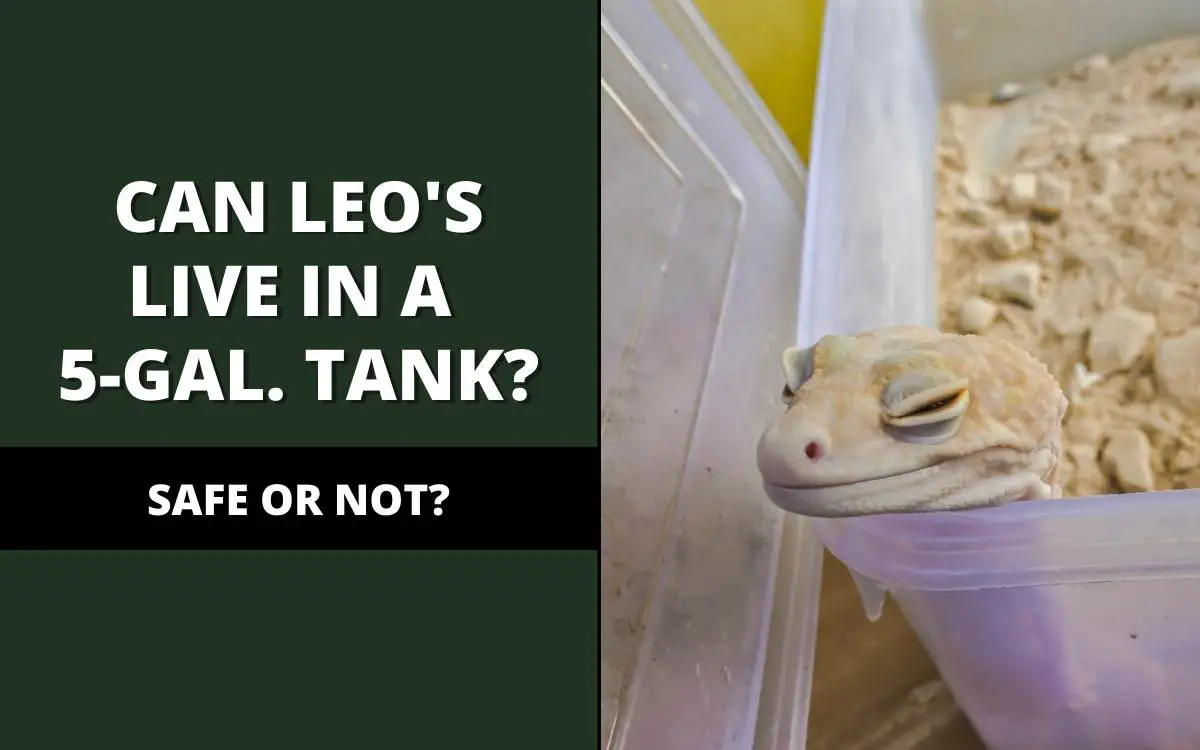Disclaimer: As an Amazon Associate I earn from qualifying purchases. Therefore, we may collect a share of sales from the links on this page, at no extra cost to you!

If you’re thinking about getting a leopard gecko, the question has probably popped into your head – can a leopard gecko live in a 5 gallon tank?
Leopard geckos are interesting creatures and require precise care in order to stay healthy and happy. Therefore, the last thing any leopard gecko owner wants to do is put their leopard geckos well-being at risk.
Many questions arise when it comes to the care of leopard geckos. Oftentimes, the answers to these questions will change depending on who you ask.
So, circling back to our original question, can a leopard gecko live in a 5-gallon tank?
No, a leopard gecko cannot live in a 5-gallon tank. This is not adequate space for your leopard gecko to survive in. Although, baby leopard geckos can live in a 5-gallon tank until they’re juveniles.
So, now that we’ve gotten that out of the way, let’s dive into the reasons why leopard geckos can’t survive in a 5-gallon tank. We’ll also discuss the tank size we recommend!
Jump to..
Why Leopard Geckos Can’t Live in a 5-gallon Tank
Leopard geckos are unique creatures in the sense that they require very specialized care. One of the most common questions is, why can’t I put my leopard gecko in a 5-gallon tank?
Well, it’s due to a few reasons. Some of these reasons include:
- Your leopard gecko will feel suffocated
- It may lead to stress and disease
- Your leopard gecko won’t have the proper temperatures throughout their tank (they require a cool side and a warm side)
- It’ll be difficult to fit all the essential accessories for your leopard gecko (i.e., hides, rocks, plants, food/water dish, etc.)
As you can tell, there are serious repercussions to allowing your leopard gecko to live in such a small space.
Can a Baby Leopard Gecko Live in a 5-gallon Tank?
Yes, a baby leopard gecko can live in a 5-gallon tank without any issues.
However, if you notice your baby leopard gecko is acting abnormally (i.e., glass surfing, lethargy, aggression), you may want to upgrade their tank.
Although most baby leopard geckos should be fine in a 5-gallon tank.
You should, however, keep in mind that you will need to upgrade your tank in the future. Therefore, if you want to save money in the long-run, you’re better off purchasing a 10-20-gallon tank upfront.
How Many Baby Leopard Geckos Can Live in a 5-gallon tank?
Personally, we recommend you never cohabitate leopard geckos, even if they’re babies.
Research has shown that leopard geckos will typically fight for resources such as heat, food, water, and more. It can lead to one of the leopard geckos being deprived of nutrients and care.
However, there are some exceptions to this rule and many people have reported that they have successfully cohabitated baby leopard geckos. This is usually more successful when housing two female leopard geckos together.
However, if you do decide to take this route, never put more than two baby leopard geckos in one 5-gallon enclosure. This is not nearly enough space for two leopard geckos.
What Size Tank Should I Get?
We always recommend a 20+ gallon tank for your leopard gecko. There’s plenty of evidence that indicates leopard geckos live longer and healthier lives in larger enclosures.
However, you can put your adult leopard gecko in a 10-gallon tank if you absolutely have to. Though, you should prioritize the health and well-being of your reptile and supply them with an adequate tank.
If you’re housing multiple adult leopard geckos in one enclosure (although we strongly advise against it) then we recommend getting a minimum of a 40 gallon tank and supply them both with their own hides, heating pads, and other accessories.
Wrapping up - Can a Leopard Gecko Live in a 5-gallon tank?
Typically, you should never attempt to house a leopard gecko in a five gallon tank.
However, if they’re newborns or babies, you may be able to get away with it up until they’re juveniles. By this point, they should be housed in a 20-gallon enclosure – or even bigger.
All in all, we hope you found this information useful. If you’re interested in learning more care-related guides, funny facts, or general advice, check out our full section covering various leopard gecko articles!
